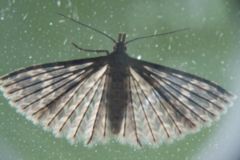- Many-plumed moth
-
Many-plumed moths 
Twenty-plume Moth
(Alucita hexadactyla: Alucitidae)Scientific classification Kingdom: Animalia Phylum: Arthropoda Class: Insecta Order: Lepidoptera Suborder: Glossata Infraorder: Heteroneura (unranked): Ditrysia Superfamily: Alucitoidea (disputed) Family: Alucitidae
Leach, 1815Type species Alucita hexadactyla
Linnaeus, 1758Diversity 9 genera, about 130 species Synonyms Alucitina Zeller, 1841
OrneodidaeThe Alucitidae or many-plumed moths[1] are a family of moths with unusually modified wings. Both fore- and hind-wings consist of about six rigid spines, from which radiate flexible bristles creating a structure similar to a bird's feather.
This is a small family, with about a global total of 130 species described to date (though it is likely that some undescribed species remain to be discovered). They are found mostly in temperate to subtropical (but not tropical) regions. But they are rare even in parts of their core range; both in Great Britain and North America for example, only one species is found – the Twenty-plume Moth (Alucita hexadactyla) – an in the latter region, it is introduced. This smallish moth can often be found fluttering in the evening twilight or resting with its "wings" outstretched. Its larvae feed on honeysuckle (Lonicera). On the other hand, in Continental Europe a considerable number of species, mostly of the large genus Alucita, occur.
Systematics and taxonomy
The taxonomy of this family is somewhat disputed. Here, they are united in superfamily Alucitoidea with the Tineodidae, a diverse group of numerous small genera with about 20 species altogether. However, the two supposed Alucitoidea families may be polyphyletic with regard to each other, and Tineodidae better included in Alucitidae. In any case, the similar-looking plume moths (Pterophoroidea) are widely held to be very close, if not the closest living relatives of the Alucitoidea.[2]
Earlier, many authors assumed that the fruitworm moths (Copromorphoidea) were also very closely related to the Alucitidae (and the fringe-tufted moths, Epermeniidae) – according to some, closer in fact than the Pterophoroidea and even the Tineodidae. In this Alucitoidea do not exist; Alucitidae and Tineodidae are assigned to different (but still most closely related) superfamilies. In the treatment here, the Copromorphoidea are presumed to be the most advanced of these lineages of small but fairly "modern" moths, while the Alucitoidea and Pterophoroidea are more primitive.[3]
Genera
The genera presently placed here, sorted alphabetically, are:[4]
- Alinguata
- Alucita
- Hebdomactis
- Hexeretmis
- Microschismus
- Paelia
- Prymnotomis
- Pterotopteryx
- Triscaedecia
Footnotes
References
 Data related to Alucitidae at Wikispecies. Version of 2010-AUG-10.
Data related to Alucitidae at Wikispecies. Version of 2010-AUG-10.- Minet, Joel (1991): Tentative reconstruction of the ditrysian phylogeny (Lepidoptera: Glossata). Entomologica Scandinavica 22(1): 69–95. doi:10.1163/187631291X00327 (HTML abstract)
- Tree of Life Web Project (ToL) (2003): Alucitoidea. Version of 2003-JAN-01. Retrieved 2011-SEP-24.
External links
Categories:- Alucitidae
- Insect families
Wikimedia Foundation. 2010.
